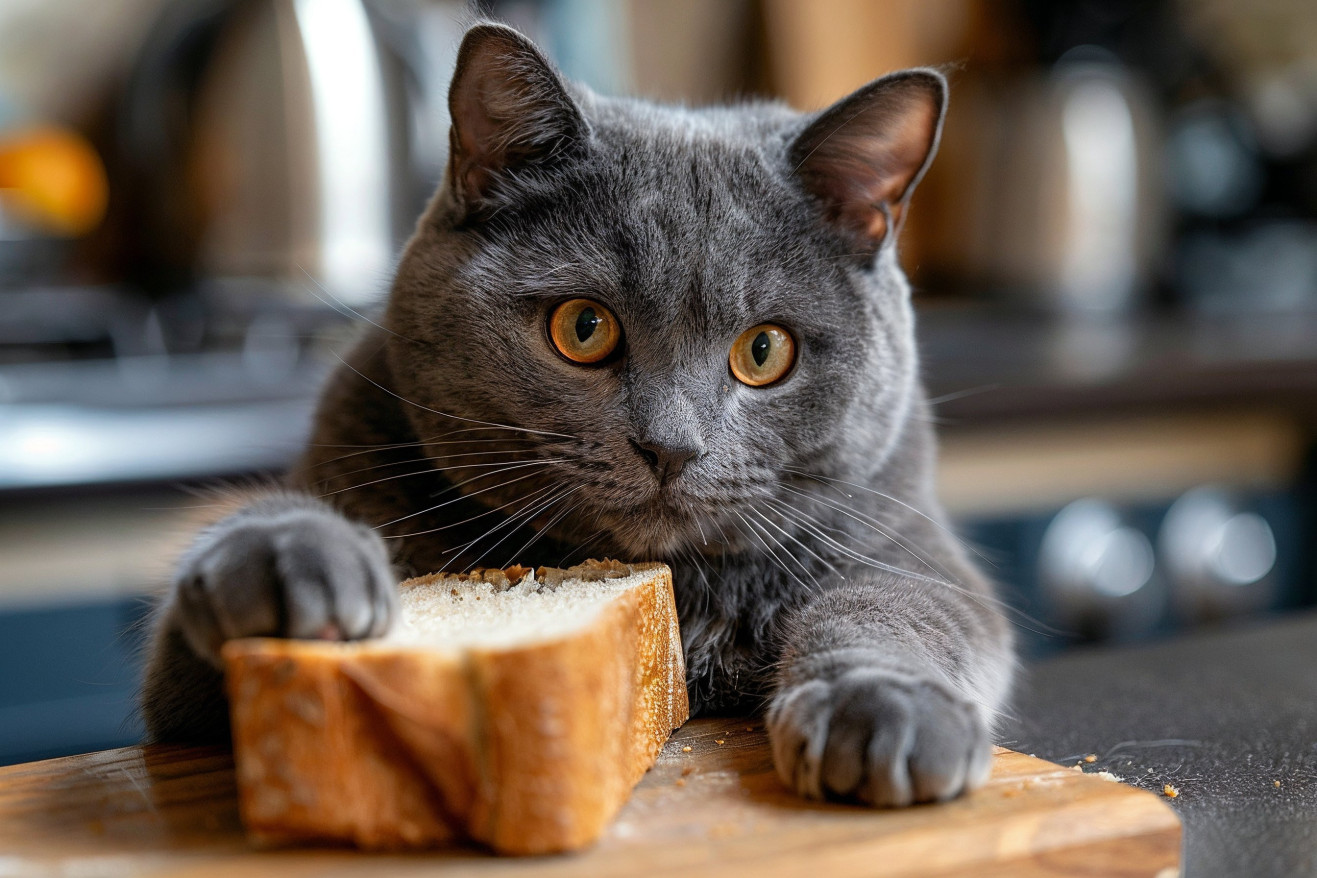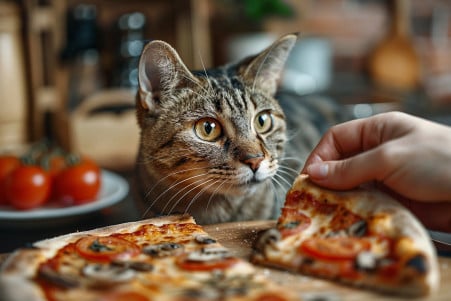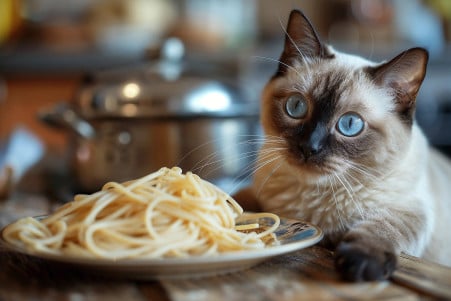Do Cats Eat Bread? A Vet Explains What Cats Should Eat
27 February 2024 • Updated 26 February 2024

If you’ve ever wanted to give your cat a taste of your food, you may have wondered if you can give them bread. While cats can have a little bit of plain, baked bread, it has no nutritional value and should not be part of a cat’s regular diet, which should be high in protein.
You should also avoid giving your cat bread that contains ingredients that are toxic to cats, such as onions, garlic, or raisins, and never let them eat raw dough.
This article will explore information from veterinarians and nutritional research to provide a more comprehensive look at what cats need in their diets. We will cover how cats digest food, what eating carbohydrates means for a cat’s health, and the dangers of feeding cats human food.
Our goal is to help you make better decisions about what to feed your cat by sharing this information and to help you understand why bread is not the best option for your furry friend.
Can cats have bread?
Cat Nutrition: The Carnivorous Nature of Cats
As the Cornell University College of Veterinary Medicine explains, cats need a high-protein diet, which is a result of their obligate carnivore status. Proteins contain amino acids that are essential for a cat’s health, including taurine and arginine—both of which are found in bread and are important for cats. The feline digestive system is designed to process animal proteins, and carbs are only a small part of their diet.
High-carb diets can lead to health issues in cats, such as obesity and diabetes. As the Countryside Veterinary Clinic explains, cats need a diet that is tailored to their specific nutritional needs, and that means that their diet should be high in animal-based proteins and low in plant-based proteins. Since bread is high in carbs and low in protein, it doesn’t contain the nutrients that cats need to be healthy.
Cats are not designed to eat a diet that is high in carbs, and their bodies are not equipped to handle it. This is important to understand because it can help you make sure that you are feeding your cat the right foods and not putting them at risk by feeding them something that they shouldn’t eat.
This is why it’s helpful to understand the details of the feline digestive system and how it has evolved to be a carnivorous one.
Anatomy of the Feline Digestive System: A True Carnivore
The feline digestive system is a highly specialized mechanism designed to process meat. It includes the mouth, esophagus, stomach, liver, pancreas, intestines, and rectum and anus. The Merck Veterinary Manual describes the pathway of food through the digestive system, starting with the enzymes in saliva that start the digestion process. This is why a diet high in protein is important for cats, as it uses amino acids and low levels of carbohydrates.
Cats metabolize proteins and fats more efficiently than carbohydrates. Their bodies produce enzymes that can break down proteins and fats, so they are able to meet their needs as obligate carnivores. However, cats don’t digest carbohydrates, like those found in bread, as well, so they can cause digestive upset.
The Merck Veterinary Manual lists a number of common feline digestive disorders, including diarrhea, vomiting, and constipation, which can be exacerbated by diets that are high in inappropriate nutrients.
Bread could lead to these issues in cats because it’s high in carbohydrates and low in the proteins and fats cats need. This is why it’s important for cats to have a diet that’s in line with their carnivorous digestive anatomy to ensure their digestive systems work as well as possible.
Understanding Feline Carbohydrate Metabolism and Its Implications
Cats have a unique way of metabolizing carbohydrates that is very different from other animals, and it is a result of their evolution as obligate carnivores. As a result, cats have a limited ability to digest starch due to a lack of intestinal enzymes that are necessary to effectively break down carbs.
A review in PMC notes that cats can experience negative gastrointestinal symptoms when they eat bread, which is a source of digestible carbohydrates that are not well-tolerated or overconsumed.
The health risks associated with a high-carb diet like the one that would be provided by eating bread can be very serious for cats and may even lead to obesity and diabetes mellitus. In fact, research has shown that low-carb diets can increase the likelihood of remission from diabetes mellitus in cats.
Meanwhile, a study in the Journal of Animal Science found that the glycemic response to dietary carbohydrates varied and that those like cassava were associated with better postprandial glycemic control.
In terms of metabolic adaptation, a study in the British Journal of Nutrition found that cats have evolved to have low hepatic glucokinase activity, which is a key enzyme in glucose metabolism.
This is another example of how cats have evolved to eat a low-carb diet in the wild, as it ensures that their glucose needs are met primarily through gluconeogenesis from protein rather than from carbs.
This information is important because it helps pet owners understand the potential dangers of feeding bread to their cats and can also help researchers better understand the specific risks associated with adding human food to a cat’s diet.
The Dangers of Feeding Cats Human Food
While it’s fine to give your cat a little bit of bread, it’s important to remember that there are certain human foods that can be harmful, and even fatal, to cats. For example, many of the ingredients that are commonly used to make bread, including onions, garlic, and raisins, are toxic to cats and can cause a range of health issues.
The University of Missouri Small Animal Clinical Nutrition Service advises against using these ingredients because they can cause gastrointestinal upset and, in more serious cases, anemia or kidney failure.
When it comes to bread, the potential dangers include the possibility that it contains these toxic ingredients or other harmful substances like xylitol, a sweetener that is poisonous to cats. According to the ASPCA Animal Poison Control Center, symptoms of poisoning from these substances can range from vomiting, diarrhea, and lethargy to more serious issues like seizures and coma. If you think your cat has ingested a toxic substance, contact your vet immediately.
To make sure that your cat stays safe, it’s best to feed them a diet that’s specifically formulated to meet their nutritional needs. While it’s okay to give them the occasional human food treat, these treats should make up no more than 10% of your cat’s daily caloric intake and should be approved by your vet.
By keeping human food, especially food that’s toxic to cats, out of their reach, you can help protect your cat’s health and well-being.
Final Thoughts: Bread and the Feline Diet
After taking a deep dive into feline nutrition, it’s clear that while cats can eat bread without any immediate danger, it’s not something that fits into their nutritional needs. Cats need a high-protein diet, and this is a requirement that goes back to their roots as obligate carnivores.
Bread, which is low in essential proteins and amino acids, doesn’t have any nutritional value for cats and can even be dangerous if it contains certain additives.
It’s important for us as pet parents to be mindful of the choices we make when it comes to our cats’ diets. We need to make sure that we’re feeding them things that are going to help them be healthy and happy while also being mindful of their natural dietary needs.
Straying from a high-protein diet can lead to health problems like obesity and diabetes, so it’s important to be mindful of the treats we give our cats.
In the end, our cats’ health is dependent on their diet. Let’s make sure we’re giving them the food they need to fill their bellies and fuel their bodies so they can live a long, happy, and healthy life.


